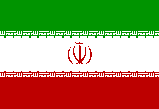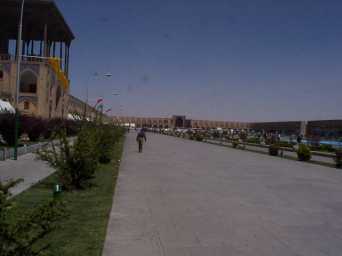 |
Emam Khomeini Square (formerly, occasionally still referred
to as Naghsh-é Jahan Square) has been the centrepiece of
Esfahan since it was built in 1612. At 500×160 metres it
is one of the largest open squares in the world. This
square and the adjoining bazaar probably has the greatest
density of rug merchants of any place on Earth. |
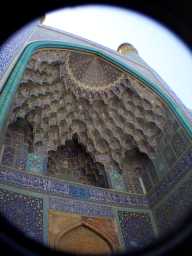 |
Entrance to the magnificent Masjed-é Emam mosque at the
south end of Emam Khomeini Square. The blue tile is
characteristic of Esfahani architecture. The portal is
30 metres tall and the minarets, visible at the top of
this wide angle shot, are 42 metres tall. |
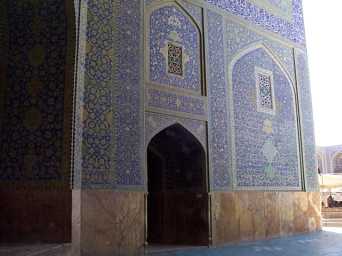 |
Interior wall in the courtyard of the Masjed-é Emam. Almost
every surface of this mosque is covered in the intricate
tile decorated with abstract and calligraphic patterns. |
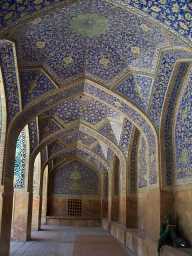 |
Hallway inside the Masjed-é Emam. The main courtyard is to
the left. The mosque was completed in 1638, having been
built over a 26 year period during the reign of Shah Abbas I. |
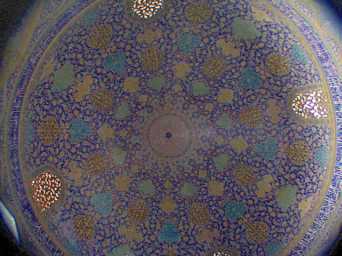 |
Main dome of the Masjed-é Emam. The dome is 54 metres in
height and is double-layered, with four openwork windows
admitting natural light. |
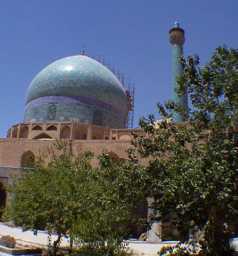 |
Exterior view of the main dome and one minaret of
Masjed-é Emam. The scaffolding on the dome is for a
tile renovation project. |
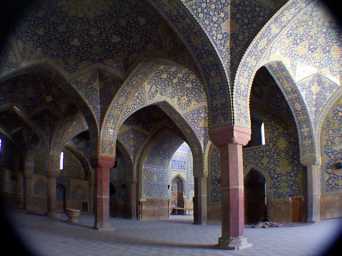 |
Interior hallway of the Masjed-é Emam, leading to the large
domed sanctuary at the south of the mosque, visible at the
centre of the frame. Sorry for all these extreme wide-angle
shots with vignetting around the edges, but the scale of
the architecture admits no alternative. |
 |
Detail of the dome above the south sanctuary. As in the main dome,
note the openwork windows. As you walk toward this room, you'll
hear an odd cracking sound echoing through the hallway. The
geometry of this dome makes it an echo chamber, and if you stand
on a paving stone and stamp your foot (or clap your hands, but
stamping appears far more popular), you'll hear multiple sharp
echoes back and forth. Everybody does this—you'll sometimes see
kids standing in a line awaiting their turn. |
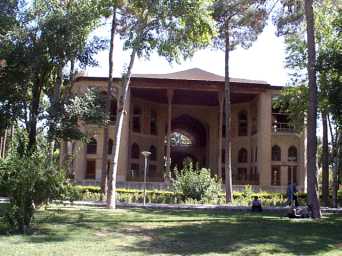 |
The Hasht Behesht (Eight Paradises) Palace,
located in the large Shahid Raja'i Park in the centre
of Esfahan was built as a garden palace during the Safavid
Dynasty (A.D. 1502–1722). |
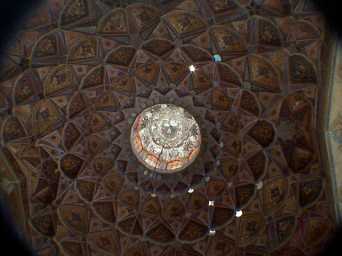 |
Dome inside the Hasht Behesht Palace. The cap of the dome,
above the windows, is entirely covered with faceted mirrors,
and mirrors are set into the rest of the dome. The use of
mirrors as architectural decoration is characteristic of
architecture of this period. |
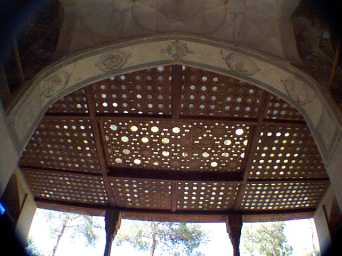 |
View of the roof of the entryway of the Hasht Behesht Palace,
showing the numerous mirrors set into the wood ceiling. |
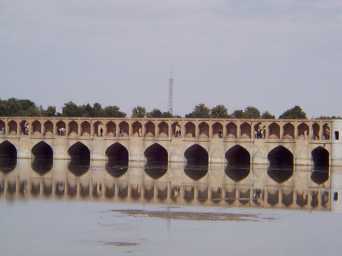 |
The Pol-é Si o Sé (Bridge of the 33 Arches) is, at 300 metres,
the longest bridge across the Zayandé River in Esfahan. It
is supposed to be restricted to pedestrian traffic, but that
doesn't deter riders of motorcycles, mopeds, and bicycles
from zooming among groups of people on foot. If you hear
one approaching from behind, the best thing is to keep walking
at the same pace and direction, since the rider is probably already
setting up to dodge you. The alcoves along both sides of the
bridge are often occupied by folks fishing in the river. This photo was
taken on eclipse day; as totality approached, all the alcoves on
the western side of the bridge filled up with eclipse chasers and
their photographic gear. There's no railing at the edge of the
bridge but, as far as I know, nobody was jostled over the edge. |
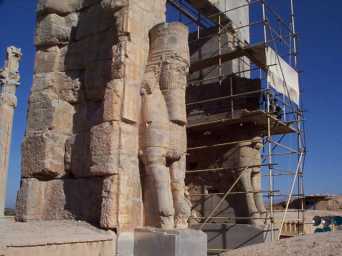 |
This imposing gate stands at the entrance to
Persepolis. It was built during the reign of
Xerxes I (486–465 B.C.). Persepolis, which originally
covered more than 125,000 square metres, was built
over a 150 year period commencing about 512 B.C. during
the reigns of the Achaemenian dynasty kings Darius I
(Darius the Great), Xerxes I and II, and Artaxerxes
I, II, and III. The name “Persepolis” is that given
to the city by Alexander, who sacked the city and burned
it to the ground in 331 B.C. Understandably, you'll rarely hear Alexander
deemed “the Great” in these parts.
The original name in Achaemenian times was “Parsa”.
Today, most Iranians refer to the site as Takht-é
Jamshid, or “Throne of Jamshid”, a mythical king of
ancient Persia. |
 |
Apadana Palace at Persepolis; this is where the kings of
Persia received visitors and accepted tribute from vassal states. The central
hall was supported by 36 stone columns, each 20 metres high. Persepolis was so thoroughly
sacked and forgotten that it was entirely covered by earth prior to
its rediscovery in the early 1930s. Conservation and
restoration work continues to the present day. There is a small
museum at the site, but many of the finest pieces have been
removed to the archæological museum in Tehran. |
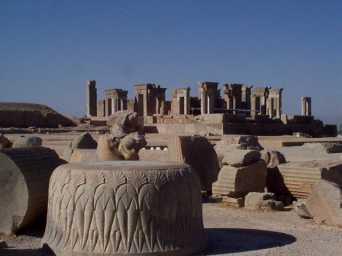 |
Ruins of the Apadana Palace with Darius' Palace in
the background. |
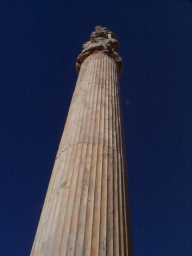 |
One of the few columns remaining at Apadana Palace. Each of the
original columns was 20 metres high and supported a wooden roof of
which no trace remains. |
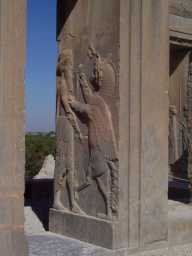 |
Carving on entryway of Darius' Palace showing Darius
slaying an evil spirit. Check out the scorpion tail
on this chimeric creature! |
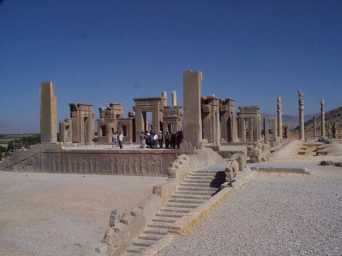 |
Overview of Darius' Palace. The well-preserved carvings at the
base and along the stairs show emissaries of vassal states
bringing tribute to the king of Persia. |
 |
This is a wide-angle view of the central part of Persepolis,
taken from the tomb of Artaxerxes II (404–358 B.C.), carved into
a mountainside above the city. Xerxes' gateway is at the very right
of the image. At the front are stables and encampments for troops,
behind which lie the ruins of the Palace of 100 Columns (only
the bases of which remain). The columns of the Central Hall of
Apadana Palace, to the left of which lie Darius' Palace, with
Artaxerxes' palace at the very left of the frame. Little remains
of Xerxes' Palace, which lies in front of Artaxerxes' from this
vantage point. The tree-shaded area to the left is the Persepolis
Museum in front of which is what's left (nothing) of Darius'
large treasury. The original city extends well to either side
of this view. |
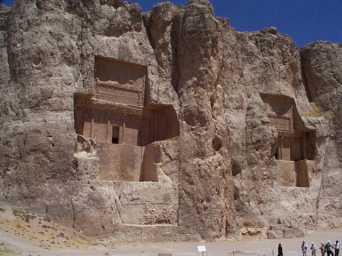 |
About 6 km from Persepolis is the Naghsh-é Rostam site in
which four massive tombs have been cut into the face of a cliff.
These are said to be the tombs of (left to right) Darius I,
Artaxerxes I, Xerxes I, and Darius II (Artaxerxes II built his tomb
in the same style in a cliff above Persepolis), but precisely whose
tombs these are and which is which appears to be a matter of some
dispute. They are architecturally consistent with that of the
later Artaxerxes II, and it makes sense that he would build his
tomb elsewhere because the cliff face at Naghsh-é Rostam was already filled
with the tombs of his ancestors. If the identification above
is correct, this image shows the tombs of Darius I and Artaxerxes I,
which would have been built around 486 and 424 B.C. respectively. |
 |
Also at the Naghsh-é Rostam site are eight reliefs carved in the stone
below the tombs which are believed to date from the Sassanian
dynasty (A.D. 224–637). This carving is said to represent
the Sassanian king Shapur I accepting the submission of the Roman
emperor Valerian who was taken prisoner at the first battle of
Edessa in A.D. 260. Valerian was the first Roman emperor to be
taken prisoner and died in Persia several years afterward. |
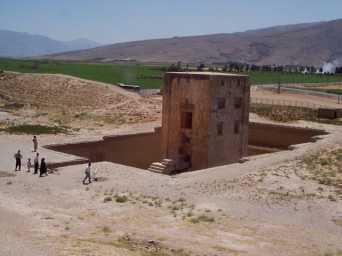 |
Prior to the Arab conquest of Persia and the introduction of
Islam in the 7th century A.D., Zoroastrianism was the predominant
religion in the region. Behind the cliff face containing the
tombs at Naghsh-é Rostam is this Zoroastrian fire-temple which
is believed to date from Achaemenian times (559–330 B.C.). An
eternal flame would have burned in the room behind the square
opening in at the front (to which the remains of the stairs
ascend), and water was directed to flow around the bottom, which is
situated well below ground level. Story has it that at the time
of the Arab conquest, Zoroastrian faithful removed the eternal
flame to a safe location and buried the temple in dirt to
hide it from the Arabs, resulting in its preservation to modern
times. Zoroastrianism is practiced to the present day by a
tiny minority (about 100,000) of Iranians. |
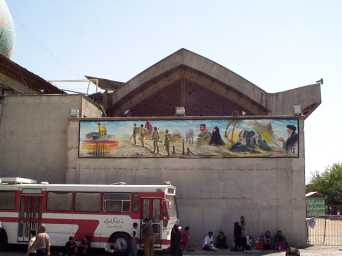 |
Memory of the 1980–1988 war between Iran and Iraq remains
strong in Iran, as does animosity toward Iraq and
Saddam Hussein. Monuments and paintings commemorating
the war and the casualties therefrom are a common sight. This mural is
to the right of the entrance to the Bogh'é-yé Shah-é Cheragh
(Mausoleum of the King of the Lamp) in Shiraz. |
 |
Main portal to the Bogh'é-yé Shah-é Cheragh
(Mausoleum of the King of the Lamp) in Shiraz; a
portion of the dome is visible at the right. This
monument was erected beginning in the 14th century
to house the tomb of Sayyed Mir Ahmad, who was killed
in Shiraz in 835 A.D., and is one of the most important
Shi'ite places of pilgrimage. |
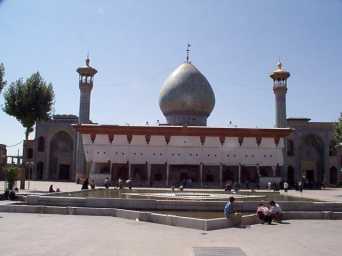 |
Central courtyard of the Bogh'é-yé Shah-é Cheragh in Shiraz,
looking back toward the dome, minarets, and entrance gates (the
outside of the gate to the right was shown in the previous picture).
The entrances to the shrine (one for men, one for women, in the
usual fashion) are at the centre of the structure below the dome.
The entire shrine is decorated in faceted mirror work and is
one of the most spectacular sights I've ever seen. Photography
is prohibited inside the shrine, so you'll have to use your
imagination (nor could a still photo possibly capture the
constantly shifting play of light and colour). |
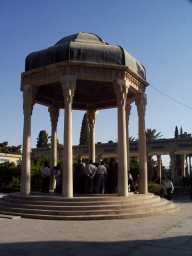 |
The Aramgah-é Hafez (Tomb of the Poet Hafez) was constructed
in 1773 by Karim Khan to house the remains of Hafez, one
of the two most celebrated poets of Shiraz. “Hafez” means
“one who can recite the Quran by memory”—his real name was
Khajé Shams-ed-Din Mohammad, which is a piece of work to recite
from memory in its own right. The pavilion over the tomb was
erected only in 1933, when the entryway (visible in the background)
and its columns were restored after being seriously damaged in an
earthquake. The shrine is set among large, well manicured gardens. |
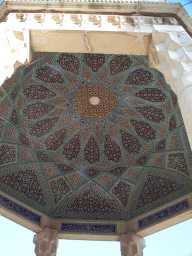 |
Dome of the pavilion above the tomb of Hafez. The tomb is
a site of pilgrimage among the young seeking advice about
their love life. It's said that if one prays above the tomb,
Hafez will provide sage counsel. |
 |
The imposing Arg-é Karim Khani (Citadel of Karim Khan)
occupies a full city block in the middle of Shiraz. It
was built during the reign of Karim Khan Zand (A.D. 1747–1779),
who moved the capital of Persia to Shiraz and
built much of the city. Agha Muhammed Khan wrested power
from the successors to Zand and moved the capital back to
Tehran where it has remained ever since. |
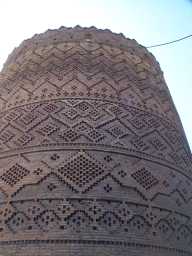 |
Detail of brickwork on one of the four towers at the corners
of the Citadel of Karim Khan Zand. |
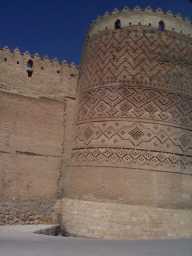 |
Strong earthquakes occur in Iran with a frequency unheard of
almost anywhere else on Earth. Quakes of 7.0 and above on the
Richter scale occur somewhere in Iran about once every five years.
So when you visit monuments, even those of only modest
antiquity, you'll often hear a litany recounting the occasions
on which it was knocked down and put back up. The southeast
tower of the Citadel is an example of this. No, this isn't
a perspective trick—that entire brick tower is leaning outward
about 15 degrees
from the walls of the structure. Earlier repairs to the base
are evident and, to date, remediation of the tilt has
amounted to patching up the resulting gap in the wall with
additional bricks. Work is said to be in progress on restoring
this monument. |
 |
I was somewhat surprised, given how seriously folks in Iran take their
religion, to find a number of shops open in Shiraz on Friday, the
Islamic holy day, and street vendors along the Zand—the main street
through the city—doing a brisk business in almost anything you can
imagine. After visiting the Citadel shown in the earlier pictures, we
stopped by the Muzé-yé Pars which was built by Karim Kahn for official
receptions. It later became his tomb; today it's the Pars Museum,
containing a number of artefacts from the Khan era and the history of
the Shiraz region. It was closed, but a number of sidewalk
booksellers had set up shop along the walls of the museum, including
this fellow specialising in engineering whose wares included—that's
right—an AutoCAD book with Sean O'Donnell's space shuttle drawing on
the cover. The book to the right was also intriguing, but I decided
it might be unwise to carry it through British customs on the way back
to Switzerland, arriving on a flight from Tehran…. |
 |
Having plenty of time before the departure of our flight
from Shiraz to Tehran on Saturday, we returned to the
Muzé-yé Pars museum, which was definitely worth a visit.
The collection is small but includes some magnificent
tapestries and illuminated manuscripts, as well as artefacts
dating to prehistoric times. Photography is not permitted in the
museum. Here's a view of the reflecting pool in the surrounding
gardens; I'm standing with my back to the museum, an interesting
building which I found no suitable vantage point from which to
photograph. |
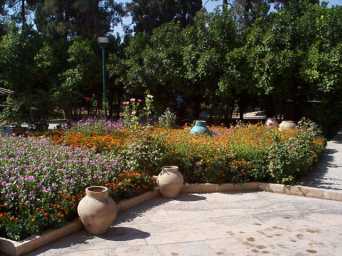 |
This is a view of the extensive gardens surrounding the Muzé-yé Pars
in Shiraz. |
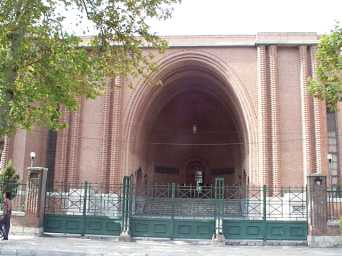 |
Due to scheduling constraints we only had a a brief time between
arriving in Tehran from Shiraz before the close of business, and we
were scheduled on an early flight the next morning from Tehran to
London. We decided to use the time available to visit the
Archælogical Museum of Iran. The entry-way to this building is
intricate brickwork like the Citadel of Zand in Shiraz which
this photo does not do justice to. |
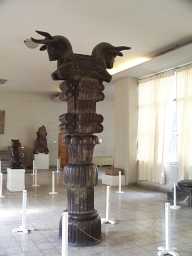 |
The Archælogical Museum is relatively small (you can see it all
in an hour or two unless you're prone to linger), and almost everything
is captioned in English as well as Farsi. Some of the most magnificent
pieces from Persepolis are here, including this pillar. The double-headed
animals are a recurrent theme in the art at Persepolis—they signify
the unity of the Medean and Parthian armies behind their Persian
emperor. |
 |
Sorry, I couldn't resist—another for my "Aliens in Archælogical
Museums" series. This grey is found in a collection of iron
figures from Loristan dating from the early first millennium B.C.
in the Tehran Archælogical Museum. |
 |
Well, I guess salt really is bad for you, if this
fellow is any evidence! You've surely heard of mummies in
Egypt, and probably about ice-mummies in Austria (or was it
Italy…?), but salt-mummies in Iran? This is the
head of a mummy found in a salt mine, preserved by dessication
by the ambient salt. Besides the head in this bell jar, there's
a boot with the remains of a leg protruding and artefacts
found along with the body, all in a climate-controlled case
in the Tehran Archælogical Museum; each item kept dry by its own
supply of silica gel. A complete paleopathological work-up of
these remains has been done and is documented in extensive
detail in a panel adjacent to the case. Unfortunately,
the museum closed seconds after I took this picture and I
didn't have an opportunity to note the details. |
